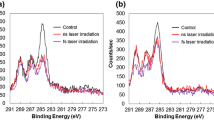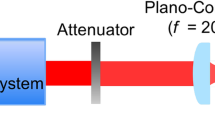Abstract
Flexible and biodegradable film substrates prepared by solvent casting from poly(3-hydroxybutyrate-co-3-hydroxyvalerate) (PHBHV) solutions in chloroform were microperforated by ultraviolet laser ablation and subsequently characterized using infrared (IR) microspectroscopy and imaging techniques and scanning electron microscopy (SEM). Both transmission synchrotron IR microspectroscopy and attenuated total reflectance microspectroscopy measurements demonstrate variations in the polymer at the ablated pore rims, including evidence for changes in chemical structure and crystallinity. SEM results on microperforated PHBHV substrates after cell culture demonstrated that the physical and chemical changes observed in the biomaterial did not hinder cell migration through the pores.

Composition showing visible and IR images of a microperforated PHBHV film, with IR spectra showing crystallinity differences between bulk film and pore rim, schematic of cell growth and propagation strategy and SEM image showing evidence of cell growth on the underside of the biodegradable substrate.








Similar content being viewed by others
References
Nair LS, Laurencin CT (2007) Biodegradable polymers as biomaterials. Prog Polym Sci 32:762–798
Causa F, Netti PA, Ambrosio L (2007) A multifunctional scaffold for tissue regeneration: the need to engineer a tissue analogue. Biomaterials 28:5093–5099
Holland SJ, Jolly AM, Yasin M, Tighe BJ (1987) Polymers for biodegradable medical devices. II. Hydroxybutyrate-hydroxyvalerate copolymers: hydrolytic degradation studies. Biomaterials 8:289–295
Holland SJ, Yasin M, Tighe BJ (1990) Polymers for biodegradable medical devices. VII. Hydroxybutyrate-hydroxyvalerate copolymers: degradation of copolymers and their blends with polysaccharides under in vitro physiological conditions. Biomaterials 11:206–215
Saito T, Tomika K, Obe K (1991) In vivo and in vitro degradation of poly(3-hydroxybutyrate) in rat. Biomaterials 12:309–312
Gogolewsky S, Jovanovic M, Perren SM, Dillon JG, Hughes MK (1993) Tissue response and in vivo degradation of selected polyhydroxyacids: polylactides (PLA), poly(3-hydroxybutyrate) (PHB), and poly(3-hydroxybutyrate-co-3-hydroxyvalerate) (PHB/VA). J Biomed Mater Res 27:1135–1148
Freier T (2006) Biopolyesters in tissue engineering applications. Adv Polym Sci 203:1–61
Williams SF, Martin DP, Horowitz DM, Peoples OP (1999) PHA application: addressing the price performance issue. I. Tissue engineering. Int J Biolog Macromol 25:111–121
Murphy MB, Mikos AG (2007) Polymer scaffold fabrication. In: Lanza R, Langer R, Vacanti J (eds) Principles of tissue engineering, 3rd edn. Academic Press, San Diego, pp 309–321
Srinivasan R (1987) Controlled degradation and ablation of polymer surfaces by ultraviolet laser radiation. Polym Degrad Stabil 17:193–203
Chen CS, Mrksich M, Huang S, Whitesides GM, Ingber DE (1998) Micropatterned surfaces for control of cell shape, position, and function. Biotechnol Prog 14:356–363
Aguilar CA, Lu Y, Mao S, Chen S (2005) Direct micro-patterning of biodegradable polymers using ultraviolet and femtosecond lasers. Biomaterials 26:7642–7649
Bettinger CJ, Borenstein JT, Langer R (2007) Micro- and nanofabricated scaffolds. In: Lanza R, Langer R, Vacanti J (eds) Principles of tissue engineering, 3rd edn. Academic Press, San Diego, pp 341–358
Serrano F, Lopez L, Jadraque M, Koper M, Ellis G, Cano P, Martin M, Garrido L (2007) A Nd:YAG laser-microperforated poly(3-hydroxybutyrate-co-3-hydroxyvalerate)-basal membrane matrix composite film as substrate for keratinocyte. Biomaterials 28:650–660
Lippert T, Dickinson JT (2003) Chemical and spectroscopic aspects of polymer ablation: special features and novel directions. Chem Rev 103:453–485
Ellis G (2002) Studies on the heterogeneity of polymeric systems by vibrational microscopy. Macromol Symp 184:37–47
Kazarian SG, Chan KLA (2006) Applications of ATR-FTIR spectroscopic imaging to biomedical samples. Biochem Biophys Acta 1758:858–867
Steiner G, Koch E (2009) Trends in Fourier transform infrared spectroscopic imaging. Anal Bioanal Chem 394:671–678
Ellis G, Marco C, Gómez M (2004) Highly resolved transmission infrared microscopy in polymer science. Infrared Phys Technol 45:349–364
Duncan WD, Williams GP (1983) Infrared synchrotron radiation from electron storage-rings. Appl Opt 22:2914–2923
Carr GL (2001) Resolution limits for infrared microspectroscopy explored with synchrotron radiation. Rev Sci Instrum 72:1613–1619
Martin MC, Schade U, Lerch P, Dumas P (2010) Recent applications and current trends in analytical chemistry using synchrotron-based Fourier-transform infrared microspectroscopy. TRAC Trends Anal Chem 29:453–463
Ellis G, Marco C, Gómez MA, Collar EP, García-Martínez JM (2004) The study of heterogeneous polymer systems by synchrotron infrared microspectroscopy. J Macromol Sci Part B Phys 43:253–266
Vogel C, Wessel E, Siesler HW (2008) FT-IR spectroscopic imaging of anisotropic poly(3-hydroxybutyrate)/poly(lactic acid) blends with polarized radiation. Macromolecules 41:2975–2977
Jadraque M, Monforte A, Núñez MT, López-García L, Martín M, Serrano F (2010) Minimally invasive automatic de-epithelization by precise ArF excimer laser ablation. Photomed Laser Surg. doi:10.1089/pho.2010.2769
Martínez G, Sánchez-Chaves M, Marco C, Ellis G (2002) Thermal degradation of 2-hydroxyethyl methacrylate-tert-butyl acrylate copolymers. Polym Degrad Stabil 76:205–210
Martelé Y, Callewaert K, Swennen I, Naessens K, Baets R, Van Speybroeck V, Waroquier M, Van Aert H, Dierickx P, Schacht E (2002) Micropatterning of polyurethanes with lasers. Polym Int 51:1172–1177
Gu J, Tay E, Lim PK, Lim P (2002) Micro-humps formed in excimer laser ablation of polyimide using mask projection system. Appl Phys A 74:487–491
Malyshev AY, Bityurin NM (2006) Laser swelling model for polymers irradiated by nanosecond pulses. Quantum Electron 3:5825–5830
Bäuerle D (2000) Laser processing and chemistry, 3rd edn. Springer, Berlin, p 599
Sato H, Murakami R, Mori K, Ando Y, Takahashi I, Noda I, Ozaki Y (2009) Specific crystal structure of poly(3-hydroxybutyrate) thin films studied by infrared reflection-absorbtion spectroscopy. Vibr Spectrosc 51:132–135
Sato H, Ando Y, Dybal J, Iwata T, Nosa I, Ozaki Y (2008) Crystal structures, thermal behaviours and C-H---O = C hydrogen bondings of poly(3-hydroxyvalerate) and poly(3-hydroxybutyrate) studied by infrared spectroscopy and x-ray diffraction. Macromolecules 41:4305–4312
Wu Q, Tian G, Sun SQ, Noda I, Chen GQ (2001) Study of microbial polyhydroxyalkanoates using two-dimensional Fourier-transform infrared correlation spectroscopy. J Appl Polym Sci 82:934–940
Bayari S, Severcan F (2005) FTIR study of biodegradable biopolymers: P(3HB), P(3HB-co-4HB) and P(3HB-co-3HV). J Mol Struct 744–747:529–534
Padermshoke A, Sato H, Katsumoto Y, Ekgasit S, Noda I, Ozaki Y (2004) Thermally induced phase transition of poly(3-hydroxybutyrate-co-3-hydroxyhexanoate) investigated by two-dimensional infrared correlation spectroscopy. Vibr Spectrosc 36:241–249
Padermshoke A, Katsumoto Y, Sato H, Ekgasit S, Noda I, Ozaki Y (2004) Surface melting and crystallization behavior of polyhydroxyalkanoates studied by attenuated total reflection infrared spectroscopy. Polymer 45:6547–6554
Xu J, Guo BH, Yang R, Wu Q, Chen GQ, Zhang ZM (2002) In situ FTIR study on melting and crystallization of polyhydroxyalkanoates. Polymer 43:6893–6899
Kansiz M, Domínguez-Vidal A, McNaughton D, Lendl B (2007) Fourier-transform infrared (FTIR) spectroscopy for monitoring and determining the degree of crystallisation of polyhydroxyalkanoates (PHAs). Anal Bioanal Chem 388:1207–1213
Padermshoke A, Katsumoto Y, Sato H, Ekgasit S, Noda I, Ozaki Y (2005) Melting behavior of poly(3-hydroxybutyrate) investigated by two-dimensional infrared correlation spectroscopy. Spectrochim Acta A 61:541–550
Galego N, Rozsa Ch, Sánchez R, Fung J, Vázquez A, Tomás JS (2000) Characterization and application of poly(β-hydroxyalkanoates) family as composite biomaterials. Polym Test 19:485–492
Sato H, Padermshoke A, Nakamura M, Murakami R, Hirose F, Senda K, Terauchi H, Ekgasit S, Noda I, Ozaki Y (2005) Infrared spectroscopy and x-ray diffraction studies on the structure and thermal behavior of biodegradable polyhydroxyalkanoates. Macromol Symp 220:123–138
Sato H, Murakami R, Padermshoke A, Hirose F, Senda K, Noda I, Ozaki Y (2004) Infrared spectroscopy studies of CH···O hydrogen bondings and thermal behavior of biodegradable poly(hydroxyalkanoate). Macromolecules 37:7203–7213
Hu Y, Zhang J, Sato H, Noda I, Ozaki Y (2007) Multiple melting behavior of poly(3-hydroxybutyrate-co-3-hydroxyhexanoate) investigated by differential scanning calorimetry and infrared spectroscopy. Polymer 48:4777–4785
Hong SG, Chen WM (2006) The attenuated total reflection infrared analysis of surface crystallinity of polyhydroxyalkanoates. Polymers 1(024):1
Garrido L, Jiménez I, Ellis G, Cano P, García-Martínez JM, López L, de la Peña E (2011) Characterization of surface modified polyalkanoate films for biomedical applications. J Appl Polym Sci 119:3286–3296
Cyras VP, Vázquez A, Rozsa Ch, Galego Fernández N, Torre L, Kenny JM (2000) Thermal stability of P(HB-co-HV) and its blends with polyalcohols: crystallinity, mechanical properties, and kinetics of degradation. J Appl Polym Sci 77:2889–2900
Li SD, He JD, Yu PH, Cheung MK (2003) Thermal degradation of poly(3-hydroxybutyrate) and poly(3-hydroxybutyrate-co-3-hydroxyvalerate) as studied by TG, TG–FTIR, and Py–GC/MS. J Appl Polym Sci 89:1530–1536
Morikawa H, Marchessault RH (1981) Pyrolysis of bacterial polyalkanoates. Can J Chem 59:2306–2313
Gonzalez A, Irusta L, Fernández-Berridi MJ, Iriarte M, Iruin JJ (2005) Application of pyrolysis/gas chromatography/Fourier transform infrared spectroscopy and TGA techniques in the study of thermal degradation of poly (3-hydroxybutyrate). Polym Degrad Stabil 87:347–354
Van de Hulst HC (1981) Light scattering by small particles. Dover, Mineola, p 76
Mohlenhoff B, Romeo M, Diem M, Wood BR (2005) Mie-type scattering and non-Beer-Lambert absorption behavior of human cells in infrared microspectroscopy. Biophys J 88:3635–3640
Romeo M, Diem M (2005) Correction of dispersive line shape artifact observed in diffuse reflection infrared spectroscopy and absorption/reflection (transflection) infrared micro-spectroscopy. Vibr Spectrosc 38:129–132
Kohler A, Sule-Suso J, Sockalingum GD, Tobin M, Bahrami F, Yang Y, Pijanka J, Dumas P, Cotte M, van Pettius DG, Parkes G, Martens H (2008) Estimating and correcting Mie scattering in synchrotron-based microscopic fourier transform infrared spectra by extended multiplicative signal correction. Appl Spectrosc 62:259–266
Bassan P, Byrne HJ, Bonnier F, Lee J, Dumas P, Gardner P (2009) Resonant Mie scattering in infrared spectroscopy of biological materials—understanding the ‘dispersion artefact’. Analyst 134:1586–1593
Lee JH, Khang G, Lee JW, Lee HB (1998) Interaction of different types of cells on polymer surfaces with wettability gradient. J Colloid Interface Sci 205:323–330
De Bartolo L, Morelli S, Bader A, Drioli E (2001) The influence of polymeric membrane surface free energy on cell metabolic functions. J Mater Sci Mater Med 12:959–963
Kai Z, Ying D, Guo-Qiang C (2003) Effects of surface morphology on the biocompatibility of polyhydroxyalkanoates. Biochem Eng J 16:115–123
Tomasi G, Scandola M, Briese BH, Jendrossek D (1996) Enzymatic degradation of bacterial poly(3-hydroxybutyrate) by a depolymerase from Pseudomonas lemoignei. Macromolecules 29:507–513
Numata K, Kikkawa Y, Tsuge T, Iwata T, Doi Y, Abe H (2005) Ezymatic degradation processes of poly[(R)-3hydroxybutyric acid] and poly[(R)-3hydroxybutyric acid-co-(R)-3-hydroxyvaleric acid] single crystals revealed by atomic force microscopy: effects of molecular weight and second-monomer composition on erosion rates. Biomacromolecules 6:2008–2016
Acknowledgments
Financial support was provided by the Ministerio de Ciencia e Innovación (MICINN), Instituto de Salud Carlos III, projects FIS PI05/2087 and PI08/1677. Synchrotron measurements performed at the U10B Beamline of the National Synchrotron Light Source, Brookhaven National Laboratory were supported by the US Department of Energy, Division of Materials Sciences, and Division of Chemical Sciences under Contract No. DE-AC02-98CH10886, and those performed at the SMIS Beamline of Synchrotron Soleil were supported by the European Union Trans National Access I3/IA-SFS Program (RII3-CT-2004-506008). We wish to thank the Beamline staff of both installations for their helpful support and advice.
Author information
Authors and Affiliations
Corresponding author
Electronic supplementary material
Below is the link to the electronic supplementary material.
ESM 1
(PDF 434 kb)
Rights and permissions
About this article
Cite this article
Ellis, G., Cano, P., Jadraque, M. et al. Laser microperforated biodegradable microbial polyhydroxyalkanoate substrates for tissue repair strategies: an infrared microspectroscopy study. Anal Bioanal Chem 399, 2379–2388 (2011). https://doi.org/10.1007/s00216-011-4653-8
Received:
Revised:
Accepted:
Published:
Issue Date:
DOI: https://doi.org/10.1007/s00216-011-4653-8




